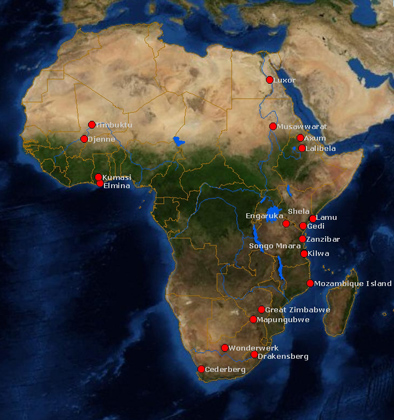Posted on May 7, 2010

One of the latest additions to the database is the Fortress San Sebastian on Mozambique Island, including the Chapel of Nossa Senhora de Baluarte, which is considered to be the oldest European building in the southern hemisphere. The fortress was documented with over 900 laser scans, showing details at a resolution of less than one centimeter in some areas. In addition to the laser scans more than 40 full dome photographic panoramas and some 1200 photogrammetric images were captured during the field campaign. The raw data set has already been into a 3D computer model, which was used to automatically generate accurate 'architectural' drawings. The data will be available to the Mozambican authorities and UNESCO for restoration work planned for this UNESCO world Heritage Site.
Another recently completed project is the documentation of the ruins of the 15th century settlement of Songo Mnara Island on the southern coast of Tanzania near Kilwa. According to John Sutton the site 'boasts the finest masonry remains of an ancient town on the Tanzanian coast'. The Zamani team documented an area of about 200 by 200 meters. Structures such as the so-called 'palace', two mosques and a number of large and complex residential buildings were recorded in the form of high resolution scans with point intervals of 2 to 3 cm. This made it possible to create an accurate 3 D model as well as very precise and detailed plans and maps, which, as is the case for all documented sites, will be integrated into a Geographic Information System(GIS). The data is available for site management and monitoring. In addition, the whole area was been covered with full dome panorama photograpgy, another standard documentation technique used by the project on all sites. The individual panoramas are connected to create an interactive panoramic tour to enable the user to explore the whole area in a virtual environment.
The Zamani documentation project is designed to capture and process spatial and contextual data of cultural heritage sites to:
- create a permanent record of important sites for future generations
- provide content for education and research
- generate metrically correct information for restoration and conservation
- increase awareness of African heritage, both in Africa and internationally
- assist with site management and tourism
Spatial data of architectural structures and historical landscapes are acquired by means of laser scanning, conventional surveys, GPS surveys and photogrammetric imaging with calibrated cameras. Satellite images,aerial photography and 360 degree (or full-dome) panorama photography are also employed as are contextual photography and videos. The data are captured by the project team during field campaigns and processed to produce a variety of output formats: Geographic Information Systems(GIS), 3D computer models with laser scanning technology, interactive panorama tours, 3D-landscape models using satellite and aerial imagery, videos and contextual photography.
The database is designed as a holistic system and therefore spatial data acquired by the Zamani group are augmented by contextual non-spatial data which is acquired by ALUKA/JStor (http://www.aluka.org) and made available to subscribed institutions worldwide. Full data sets of sites are handed over to appropriate government institutions in the countries in which the respective sites are located.
To date the Zamani team has documented some 25 sites with more than 70 individual structures/rockshelters in ten African countries , to which Mozambique Island and Songo Mnara can now be added. These sites include: Kilwa Kiswani, Engaruka, Stone Town – Zanzibar (Tanzania) - Lalibela, Axum (Ethiopia) - Elmina castle , Besease Temple (Ghana) - Djenne, Timbuktu (Mali), Great Zimbabwe (Zimbabwe) - Lamu, Shela (Kenya) - Valley of the Queens (Egypt) - Musawwarat es-Sufra (Sudan) - Wonderwerk Cave, Rockshelters in the Cederberg and Drakensberg, Mapungubwe, Cape Town Castle [in progress] (South Africa)
The Zamani initiative was conceptualised in the Geomatics Division of the University of Cape Town by Professor Heinz Rãther in 2001 and implemented in 2004 through a number of sequential grants from the Andrew W. Mellon Foundation, New York. The data generated by the project are made available through the Aluka/JStor on-line-digital library to educational and research institutions, museums, as well as to government departments of Culture, Antiquities and/or Tourism. Documentation projects were also carried out for the Getty Conservation Institute, Los Angeles and the World Monuments Fund, New York. In the early stages of the project UNESCO provided financial support for documentation in Lalibela.
Heinz Rãther is the Principal Investigator of the African Cultural Heritage Sites and Landscapes Database, Geomatics Division, University of Cape Town.
Heinz.ruther@uct.ac.za